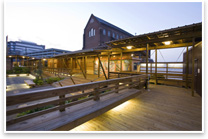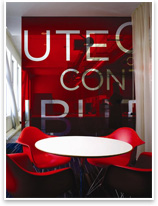 Piecing Together Community in New Orleans Piecing Together Community in New OrleansAn award-winning homeless shelter that plans for temporary trailers, not around them Wayne Troyer Architects’ Rebuild Center responds to serious budget and time constraints with a design that hides the mass and expression of single-function temporary trailers behind wooden trellises, walkways, and canopies. This plan buries the trailers in a unified, non-institutional context and offers homeless patrons a dignified and inviting, though temporary, place to gather.
Copyright or Copy Wrong? |
||
Copyright 2008 The American Institute of Architects. All rights reserved. Home Page |
||
news headlines
practice
business
design
This is the home of the weekly Best Practices column, news of tips and tools that you can use in your day-to-day practice and case studies illustrating “how-tos” and “lessons learned” for all stages of practice. The Practice Zone also features reports of research in architecture and related fields.

 Interior Architects Help Seattle Credit Union Embrace Change
Interior Architects Help Seattle Credit Union Embrace Change